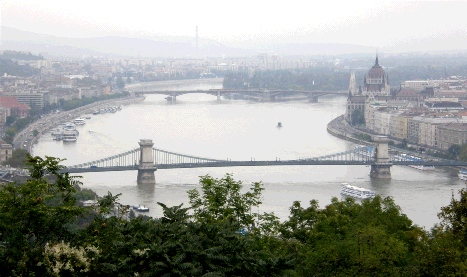In October 2010 we travelled to three countries in the Middle East: Egypt; Syria and Jordan. While in Egypt we took a Nile cruise, effectively an organised tour package complete with guide, but otherwise we travelled independently: by cab; rental car (in Jordan); bus; train and plane.
On the way there we had stopovers in London and Budapest to visit friends.
The impact on me was to reassert the depth, complexity and colour of this seminal part of our history and civilisation. In particular this is the cauldron in which Judaism, Christianity and Islam were created, together with much of our science, language and mathematics.
The history of technological development is also recorded from the Stone Age (upper Palaeolithic and early Neolithic), through weaving and pottery making to smelting copper, tin, gold, silver and bronze then to iron. We see the invention of the light spoked wheel, leading to the development of chariots in warfare; advances medicine; sailing; and civil engineering; each technology advance supporting or symbiotic with changes in social structures and agricultural and manufacturing methods.
In this respect the museums were very useful to essential, in interpreting the numerous ruins, remains and layers of successive cultures. I was very grateful for first having visited the British Museum and the Hungarian National Museum in Budapest, both sophisticated modern institutions, well laid out and documented, before arriving in Egypt and then for a day in the more chaotic but vast Egyptian Museum in Cairo, before setting out to try to put everything we saw into context.
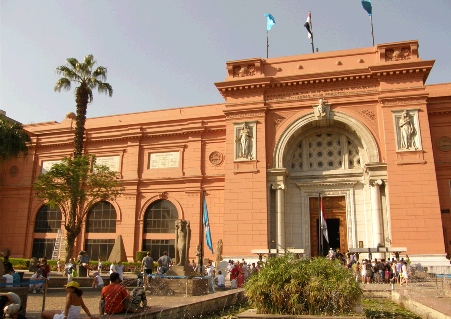
Egyptian Museum Cairo
There were also unexpected gems along the way like the museum on the Citadel in Amman, Jordan (once Rabbath Ammon then Philadelphia, named after Ptolemy Philadelphus during Greek rule) that, with archaeological contributions from Sydney University, contains ceramic statues over 8,000 years old as well as earlier Neolithic tools and a good sample of early bronze age and iron objects, all the way through Greek and Roman periods (a lot of glass). Most of these were found locally in the midst of the Roman, Christian and Islamic ruins. The Museum even contains sections of the Dead Sea Scrolls. Other museums were disappointing like the one in Damascus, with some interesting objects but largely closed for renovation.
Together the remains of past human activity build a picture of mankind’s progress from early Homo erectus and Neanderthal hunter gatherers in Hungary; the arrival of modern Humans; early settlements around ten thousand years ago; the evolution of agriculture; the development of increasingly sophisticated technology and weapons; the rise of kings, warriors and priests, resulting in increasingly grand palaces; fortifications; temples; and mausoleums.
The remains of grandest of these early human political and power structures are in Egypt, attesting to the enormous wealth of the Nile region before the micro climate changed, reducing these lands and the communities they support to the, often abject, poverty we see today. Perhaps these climate changes were anthropogenic as a result of overpopulation, early agricultural practices and over-exploitation of the cedar and other forests but these were undoubtedly contributed to by natural climate change as the world emerged from the last ice age; a lesson for the present time?
Despite their builders' hubris and unrequited commitment to their gods, these huge constructions have long since fallen into ruin. But the ideas they embodied have not. As many scholars have noted, these early perceptions of man’s central role in the universe and his intimate interactions with his gods have flowed on, intermixed with those of Greece, Rome and northern Europe to produce the dominant religions of today, as well as the many flavours of those beliefs and intellectual fabrications.
View an interesting academic discussion of these origins and interactions: Science, Magic and Religion
These religious ideas have supported subsequent grand construction projects all the way to the vast and beautiful cathedrals of Europe and for at least ten millennia endorsed the divine right of kings to rule and conquer. They also fostered and supported civilisations and cultures capable of subtle ideas, beautiful art, and one imagines, music. Today the Middle East contrasts dramatically with London and Budapest.
In Britain and Hungary cities are resplendent with the culture of the modern era: from classical to modern painting, music and theatre.
Watch Slideshow: London Tate Modern St Pauls
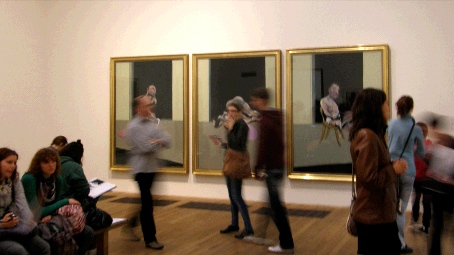
At The Tate Modern, London – a hive of activity and interest
Bookshops and music retailers dot the retail areas as do specialist interest retailers of all kinds. There are numerous world leading universities and a high proportion of the populous are graduates.
It is possible to imagine that the ancient civilisations of Egypt, at the forefront of contemporary life, also supported or tolerated a wide diversity of cultural activities and beliefs. But just as the region is now desertified and impoverished, so much of it is in stark cultural contrast to the streets of London or Budapest. While there is a grand new, very modern library in Alexandria, most of the city is in an advanced state of decay. Cairo is bursting at the seams with overpopulation.
The arts across the region appear to be rooted in the past, particularly in religion. This is not surprising as Egypt has seen better days. Clearly there was something of a boom in wealth during the last century with many opulent buildings constructed across Egypt. But now most of these are in decay or even collapsed. The population has grown the point of un-sustainability and many of the younger generation are unskilled. Egypt has the lowest literacy rate in the Middle East mainly due to the poverty a large part of the population and the lack of education for girls.
For such a large country there is little evidence of any significant contemporary art culture, although there is a popular music industry and in some areas internet and phone pornography. Our TV in Cairo had 61 religious channels including a lot of ‘born again’ stuff from America surprisingly interspersed 33 for phone or internet sex. Maybe this is a subtle population control measure to offset the ‘go forth and multiply’ message of the others. This formed the vast majority of the channels, sharing the spectrum with a handful of channels for movies and games shows and half a dozen for news, mainly from Europe. Several channels were blocked. Goodness knows what these had on them[2].
Syria has many of the features of a police state having been under Emergency Law since 1962. Pictures of the President, Bashar al-Assad, adorn almost every building, public and private. They are still getting over being attacked (they believe unprovoked) by Israel in 2003 (alleged terrorist training centre) and 2007 (nuclear reactor) and the earlier Israeli occupation of the Golan Heights. Border security is tight and men dressed like Mormons with suits concealing guns prowl the city. And bus staff wants to know a bit too much about one’s movements. Despite this, Damascus was generally the most pleasant and interesting city we visited. Amman is the most conventionally modern city, with the best hotel we had in the region, was but it lacks the charm of Damascus.
Jordan and Syria have compulsory education to middle school and high rates of school attendance. But throughout the region general education seems to be rudimentary at best: hardly anyone can read a map, including the car hire representative and the concierge in Amman, who although fluent in English, was unaware of the existence of the museum at the Citadel.
In Egypt cab drivers, particularly of black and white cabs, are generally illiterate and navigate, as in India, by known landmarks or the ‘drive, stop, and ask directions method’. Once you have your bearings you need a map and to be able to direct them yourself or simple journeys can take hours.
Our University trained Egyptian guide on the Nile tour could not even guess at the age of the limestone in which the tombs in the Valley of the Kings are carved. It seemed to be something he had never considered. I asked if they had started by exploiting natural limestone caves an idea he completely dismissed.
But a quick look at Wikipedia revealed: ‘The tombs are located in the alternating sandwich of dense limestone between other sedimentary rock (which form the cliffs in the valley and the nearby Deir el-Bahri) and soft layers of marl. The sedimentary rock was originally deposited between 35 & 56 million years ago… The builders took advantage of available geological features when constructing the tombs. Some tombs were quarried out of existing limestone clefts, others behind slopes of scree, or were at the edge of rock spurs created by ancient flood channels.‘

The tomb of Twosret and Setnakhte - from the web – no photography in the tombs
He also wanted to argue that the Rosetta stone is in the Louvre in Paris even though I insisted I had just seen it in the British Museum in London, and he claimed ancient Egyptian gold was more pure than modern gold at 35 carets. He was genuinely shocked on another occasion when it was mentioned by our fellow Australians on board the boat that many people in Australia are not religious, replying ‘but God made the world’. To which he got the obvious response ‘then who made God’. At that point his distress became obvious saying: ‘that is an illegal question’, so we quickly changed the subject.
The status of women in the culture of the Middle East is well known, but it appears to vary from place to place. Women are never numerous in public, among a relative sea of men and most have scarves and or veils. But in the cities head scarfs are not universal, even among locals. Elsewhere the only adult women exposing their hair are foreigners or Christians. Christians constitute a sizeable minority throughout the Middle East of around ten percent. There is a Christian ghetto in Damascus. Our Egyptian guide was interesting on the subject of veils. He is engaged to be married to another guide but expects her to be veiled, and presumably to give up her job, when they marry. He told us that until marriage a woman should obey her father’s wishes as to the veil but after marriage, her husband’s. If she is beautiful he will not want other men to be looking at her lustfully, but if she is plain this won’t be an issue.
History
To put the numerous ruins and archaeological records we were confronted with in to order, it was essential to envisage the historical time line. In the Bronze and early Ion Ages religion was central to society, culture and technology. The elaborate Egyptian preparations for life after death are responsible for much we see preserved today. But I suffered information overload trying to remember nearly 200 pharaohs and important priests and neighbouring kingdoms. Knowing which god is responsible for what becomes relevant for me only when it influenced intellectual development or world events, such as a Persian victory aided by their enemy’s reverence for cats. Thus a lot of the temple and tomb cartoons, cartouches and hieroglyphics are little more than pretty pictures to me except when they depict some change in knowledge or illustrate a capability like those depicting wars, medical procedures or mathematics.

Gods with Pharaoh at Kom Ombo (temple of the crocodile god Sobek, creator of the world)
The Egyptian records are extensive and span thousands of years. They can be accurately dated at several points when they record astronomical events such as eclipses and comets and the eruption of the Volcano on Thera (Santorini), the dates and times of which we know with varying degrees of accuracy. In Egypt the rise of the old kingdom corresponds with the early Bronze Age and the weapons this made possible. The Bronze Age lasted for around 2000 years ending with the advent of iron weapon technology. Iron weapons and superior naval technology led to military success by invaders called 'sea peoples' in the Egyptian records, and their sacking of many Bronze Age cities and settlements, particularly in Greece. The early Iron Age corresponds with the Greek Age of Heroes and the historical fall of Troy. This was a period of significant dynastic changes and social disruption with the loss of high culture and a decline in classical literacy (known as the Greek Dark Ages). The social disruption resulted in the evolution of new religions challenging established beliefs, including Egyptian monotheism and Judaism.
It is tempting to try to use the Old Testament Bible account particularly in Exodus to correlate it with events in Egypt, and thus date or confirm the events recorded there, but alas scholars have so far been unable to find an incontrovertible reference to any of those events. Wikipedia reports: 'More than a century of archaeological research has discovered nothing which could support the narrative elements of the book of Exodus—the four centuries sojourn in Egypt, the escape of well over a million Israelites from the Delta, or the three months journey through the wilderness to Sinai. The Egyptian records themselves have no mention of anything recorded in Exodus, the wilderness of the southern Sinai peninsula shows no traces of a mass-migration such as Exodus describes, and virtually all the place-names mentioned, including Goshen (the area within Egypt where the Israelites supposedly lived), the store-cities of Pithom and Rameses, the site of the crossing of the Red Sea (or, more commonly among modern Biblical scholars, the Sea of Reeds), and even Mt Sinai itself, have resisted identification.' Indeed the Iliad, written over 400 years after the fall of Troy, appears to provide a more reliable historical record of the period in that it refers to real places and events.
The Egyptian Museum has a considerable collection of objects from the brief monotheistic period under the Pharaoh Akhenaten (Eighteenth dynasty who ruled for 17 years and died in 1336 BC or 1334 BC) which some believe to be the origin of Judaism. Biblical scholars have traditionally claimed the pharaoh who allegedly pursued Moses out of Egypt was Ramesses11 (1279 -1213 BC). This is probably because he is the best known of all the New kingdom pharaohs. But despite a vast and growing contemporary documentation there is no record of any of the biblical events during his reign. Seven other pharaohs have also been argued for by various biblical scholars, all relying on non-literal interpretations of one or more of the events: wars, plagues, crop failures and so on.
A group of non-biblical scholars assert that that Moses may have fled Egypt after Akhenaten's death (ca. 1334 BCE) when many of the pharaoh's monotheistic reforms were being violently reversed. The principal ideas behind this theory are: the monotheistic religion of Akhenaten being a possible predecessor to Moses' monotheism, and the 'Amarna letters', written by nobles to Akhenaten, which describe raiding bands of 'Habiru' attacking the Egyptian territories in Mesopotamia.
Wikipedia asserts that: 'It is widely accepted that there are strong similarities between Akhenaten's Great Hymn to the Atenand the Biblical Psalm 104, though this form is found widespread in ancient Near Eastern hymnology both before and after the period and whether this implies a direct influence or a common literary convention remains in dispute.'
The following table, also from Wikipedia, sets out a verified chronology prior to the conquest of the Egypt by Persia, then by the Greeks under Alexander the Great and subsequently by Rome and on into the common era.
| Stone Age | Chalcolithic (4500 BCE - 3300 BCE) |
Early Chalcolithic | 4500 BCE - 4000 BCE | Ubaid period |
| Late Chalcolithic | 4000 BCE - 3300 BCE | Ghassulian, Uruk period, Gerzeh, Predynastic Egypt | ||
| Bronze Age (3300 BCE - 1200 BCE) |
Early Bronze Age (3300 BCE - 2000 BCE) |
Early Bronze Age I | 3300 BCE - 3000 BCE | Protodynastic to Early Dynastic Period of Egypt |
| Early Bronze Age II | 3000 BCE - 2700 BCE | Early Dynastic Period of Sumer | ||
| Early Bronze Age III | 2700 BCE - 2200 BCE | Old Kingdom of Egypt, Akkadian Empire, Great Khufu Pyramid (Cheops in Greek) 2580-2560 BCE | ||
| Early Bronze Age IV | 2200 BCE - 2000 BCE | First Intermediate Period of Egypt | ||
| Middle Bronze Age (2000 BCE - 1550 BCE) |
Middle Bronze Age I | 2000 BCE - 1750 BCE | Middle Kingdom of Egypt | |
| Middle Bronze Age II | 1750 BCE - 1650 BCE | Second Intermediate Period of Egypt | ||
| Middle Bronze Age III | 1650 BCE - 1550 BCE | Hittite Old Kingdom, Minoan eruption | ||
| Late Bronze Age (1550 BCE - 1200 BCE) |
Late Bronze Age I | 1550 BCE - 1400 BCE | Hittite Middle Kingdom | |
| Late Bronze Age II A | 1400 BCE - 1300 BCE | Hittite New Kingdom, Mitanni, Ugarit, Akhenaten (Amenhotep IV) and monotheism 1353-1336 BCE | ||
| Late Bronze Age II B | 1300 BCE - 1200 BCE | Ramesses II (Ramesses the Great) 1279-1213 BCE | ||
| (Greek Dark Age, Sea Peoples) | ||||
| Iron Age (1200 BCE - 539 BCE) |
Iron Age I (1200 BCE - 1000 BCE) |
Iron Age I A | 1200 BCE - 1150 BCE | Troy VII, Hekla 3 eruption |
| Iron Age I B | 1150 BCE - 1000 BCE | Neo-Hittite states | ||
| Iron Age II (1000 BCE - 539 BCE) |
Iron Age II A | 1000 BCE - 900 BCE | Neo-Assyrian Empire | |
| Iron Age II B | 900 BCE - 700 BCE | Kingdom of Israel, Urartu, Phrygia | ||
| Iron Age II C | 700 BCE - 539 BCE | Neo-Babylonian Empire |
In 525 BCE Egypt was decisively defeated by the Persians under Cambyses II at the Battle of Pelusium, transferring the throne of the Pharaohs to Persia. Persia had already conquered most of the Middle East and Asia Minor under Cyrus the Great, Cambyses father. The Persians were at the peak of their military prowess and in addition (according to Herodotus) used a cat emblem (the Egyptian god Bastet) on their shields so that the superstitious Egyptians were unwilling to strike them. 50,000 were reported slaughtered with relatively minor Persian losses. After the battle Herodotus reports: Cambyses carried a cage of cats in front of him on his horse, and hurled them into the faces the defeated Egyptians ‘with insulting taunts and laughter’.
The son of Cambyses, Darius the Great of Persia became Pharaoh of Egypt. Subsequent rulers were subservient to Persia, to a greater or lesser extent, for 200 years until the Persians were defeated by Alexander the Great in 330 BCE. Alexander famously founded Alexandria and began the Hellenistic (Greek) period in Egypt that was consolidated under Ptolemy (one of Alexander’s generals) and his successors, ending with Cleopatra in 30 BCE
[3]. Egypt then became the Roman province of Aegyptus.
Thus began a period of dramatic change and turmoil as civilisations collapsed and were remade.
Under the Emperor Constantine I the Roman Empire was ruled from Constantinople (previously Byzantium). In the fourth century of the common era the Roman Empire divided, and Christianity became the official religion. The Middle East found itself part of the Byzantine Empire (eastern Empire) based on Constantinople.
In 476 the Western Roman Empire, fell to the Ostrogoths, further consolidating Byzantine Christianity in the Middle East (Egypt and the Holy Lands) and the resurgence of Greek as the dominant language. In Egypt the Christians set about the removal of pagan traditions starting with the eradication of Egyptian priests and priestesses who officiated at the temples. Soon no-one could read the hieroglyphics of Pharaonic Egypt, and its temples were converted to churches or abandoned to the desert. In some places they set about the systematic chiselling out of the faces of the gods depicted in the temples, as can be seen today.
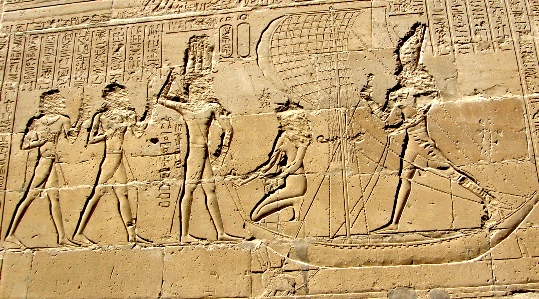
Defaced images at Edfou Temple – Pharaoh defeating a Hippopotamus (below) –the representation of evil
Representing, even Christian, religious images had been contentious since the foundation of Christianity. A fundamentalist, iconoclastic faction saw these as pagan and contrary to scripture[4].
Meanwhile in the year 610 of the common era, a 40 year old merchant called Muhammad, discontented with life in Mecca, retreated to a cave in the nearby mountains to meditate. In this cave he received a revelation from God that: ‘God is One; and that complete surrender to Him is the only way acceptable to Him’. He returned to Mecca and founded Islam. The new faith struck a chord for that time and place and quickly gained a following. But he threatened the existing order and encountered hostility from the leaders in Mecca. In 622, he and most of his followers fled to Medina (Yathrib) where he succeeded in uniting conflicting Arab tribes. Ten years later his forces successfully defeated his opponents in Mecca. A few months after his return to Mecca he died but by the time of his death, most of the Arabian Peninsula had converted to Islam; and he had united the tribes of Arabia into a single Muslim jihad. Two years later, in 634, the Arabs took Syria including Jerusalem.
Immediately prior to this, in 619, the Sassanid Persian army had taken Alexandria, the capital of East Roman Christian (Byzantine) Egypt. Within two years all of Christian Egypt had fallen to the Sassanids who tolerated Christianity but followed the prophet Zoroaster (Zarathustra) and worshiped Ahura Mazda as their supreme divine authority.
In December 639 Caliph Umar, successor to Muhammad, sent an army of 4,000 Arabs led by Amr Ibn Al-Aasto enforce Islamic rule to the west. They swept into Egypt from Palestine advancing rapidly into the Nile Delta. The Imperial garrisons retreated into the walled towns, where they successfully repelled the invaders. But the Arabs sent for reinforcements, and in April 641 they captured Alexandria. The Byzantines assembled a fleet and took Alexandria in 645, but the Muslims retook the city in 646, completing the Muslim conquest of the Middle East. These battles are illustrated, somewhat confusingly, with appropriate objects and exhibits in the Museum at Alexandria.
In the 11thcentury Muslim expansion was pushing into Asia Minor (Turkey) and the Byzantine Emperor appealed to the Pope for help. The first Crusade was organised and the Holy Lands came under attack from Christian Crusaders. In 1099 after massacring Muslims and Jews, they successfully established the Christian Kingdom of Jerusalem but despite similar extreme violence against other Muslim cities, things did not go well for the Crusaders. The third Crusade failed at the hands of Salah ad-Din (Saladin) who had replaced the failing Egyptian rulership as vizier; becoming Sultan of Egypt in 1171.
The Kingdom of Jerusalem was then surrounded by Syria and Egypt and fell in 1187. Egypt was subsequently seen as the key to the Christian recapture of the Holy Lands and the Fourth; Fifth; Seventh; Eighth; and Alexandrian Crusades all had Egypt as the intended target. Despite some initial successes all eventually failed. In 1291, Acre, the last major Crusader fortress in the Holy Land fell to the forces of the Mamluk Sultan of Egypt.
Richard I of England (the Lion-heart) was the central military commander of the third Crusade and his good opinion of Saladin raised the latter’s reputation to a mythic figure across Europe, as well as in the Middle East. There is a famous bronze sculpture to Saladin outside the citadel in Damascus, near the entrance to the largest Souq in the old city and he is often represented favourably in literature and film. An equally famous statue of Richard I stands outside the Palace of Westminster in London but references to him in films and popular myth, particularly the Robin Hood legends, are almost certainly untrue.
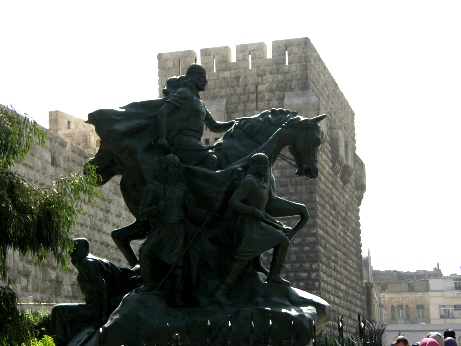
Saladin outside the citadel in Damascus
Napoleon was the next to successfully and quickly invade the region. But his navy was defeated by the British Navy (Nelson) at the Battle of the Nile in 1798 and his army subsequently at Waterloo, signalling a period of European and Ottoman imperialism in the region; with Africa soon divided into colonies by various European powers.
The Modern Period
In the 20th century, North Africa provided the sites for a series of battlefields in world power struggles; the competition for markets and resources, particularly oil; and ongoing religious conflict over Jerusalem.
After the French, at the beginning of the 19th Century, Egypt had fallen to the Ottomans under Muhammad Ali Pasha and his dynasty prevailed for around eighty years. But with the building of the Suez canal (1859-69) French and British 'controllers' sat in the Cabinet and effectively governed the country.
In 1882 the British formally occupied Egypt as a protectorate and retained a strong influence until 1952. For most of this time Egypt was nominally self-governing, at first under the Ottomans until the collapse of the Ottoman Empire in World War1. This was followed by political turmoil resulting in a Unilateral Declaration of Independence by Britain in 1922. An election then took place and in 1923 Egypt became a constitutional monarchy under King Fuad (a descendent of the Ali Pasha dynasty). After King Faud died the crown passed to the notorious young playboy - King Farouk.
The new kingdom was plagued by civil unrest. Many of the disgruntled, including the Communists and Muslim Brotherhood, pointed to endemic corruption and characterised the Government as a puppet of the British, who retained a strong military presence in the Canal Zone.
In 1947 the British withdrew from neighbouring Palestine, much of which was promptly seized by Zionist paramilitary units, contrary to a UN agreement. Egypt led by Farouk was among the Arab allies that attempted to recover the lost Arab territory. This Arab alliance was soundly defeated by the new State of Israel, between 1948-1949 and even more territory was lost.
The resulting disenchantment with the monarchy led to a bloodless coup in 1953 when the Free Officers Movement, led by Gamal Abdel Nasser, seized power. King Farouk was forced to abdicate in favour of his nine-month-old son. But the monarchy was soon dispensed with altogether and the Republic of Egypt proclaimed.
Nasser began his period as supreme leader by styling the coup a 'Revolution' and himself 'President'. He consolidated power with a wide range of popular land reforms and in 1956 he seized the Suez Canal, to domestic acclaim that still echoes today.
The same year he developed an alliance with the Soviet Union (USSR) that resulted in significant infrastructure improvements, in particular the Aswan High Dam, funded and built by the USSR.
Under Nasser's education and health reforms the middle classes began to grow and there were grounds to believe that one day the country may return to democracy. But this was a command economy led by generals and things did not go well.
Possibly to distract public opinion from the failing economy or to regain the glory of his Suez victory, Nasser began to make bellicose threats against Israel. In the middle of 1967 he closed Straits of Tiran to Israeli shipping, distressing them mightily to the glee of his supporters.
Twelve days later, on the 6th June, Israel pre-emptively attacked, destroying the majority of the Egyptian Air Force. During the 'Six Days War' that followed, Nasser's Army and those of his Arab allies were ignominiously routed, losing even more Arab territory in Palestine, in addition to the Sinai peninsular and briefly the Suez Canal. Arab to Israeli losses were 20 to 1.
To suppress protest at home martial law was implemented and dissent ruthlessly suppressed.
After his death by natural causes (heart failure - heavy smoker) in 1970 at the age of 52, Nasser was replaced by his Vice President, Anwar Sadat.
Sadat expelled advisors from Soviet Union and switched alliance to the United States. In 1973, together with Syria, he attacked Israel and regained control of the Sinai territory lost six years earlier. This resulted in 'super-power' intervention and the 'Camp David Peace Accords' with Israel. For this he and and Israeli Prime Minister Menachem Begin won a Nobel Peace Prize.
But this did not please Arab extremists and in 1981 Sadat was assassinated to be replaced in turn by his Vice President Hosni Mubarak. That another general stepped-up was not a surprise to anyone. Egypt was still under martial law*.
Today it is obvious to any visitor who cares to take notice that Egypt was once much more prosperous. The fine houses and apartments built during the Kingdom now lie in the final stages of decrepitude. Once impressive public buildings are run down and shabby. Misgovernment, military adventures and runaway population growth during the past fifty years have done their work. Ever since Nasser's Revolution Egypt has depended on foreign aid to stay afloat, first from the USSR and now from the USA.
Back then it was certainly an unequal society. Of its then 20 million inhabitants in 1950 as many as 80% were judged poor and uneducated while 20% lived relatively cosmopolitan lives and enjoyed most of the wealth. Their playboy king led the way.
World Bank and UN statistics show that on the whole Egypt is now both more equal and better educated than fifty years ago. But in the intervening years the population has grown to over 80 million and the number of poor and uneducated has exploded, wreaking havoc on all its urban environments and even on Egypt's ability to feed itself. Today as many as 20 million are malnourished to the point of giving birth to stunted children.
*2015 Addendum: Martial law was briefly removed from 2011 to 2013 during the 'Arab Spring' and a brief flirtation with democracy, under President Morsi, but after his overthrow it's now reimposed with even greater restrictions.
Technology
The things I found interesting were the technical and intellectual capabilities implicit in the engineering architecture; manufactured products, like jewellery and weapons; and scientific knowledge implicit in the practices and beliefs at different periods over 10,000 years of human civilisation.
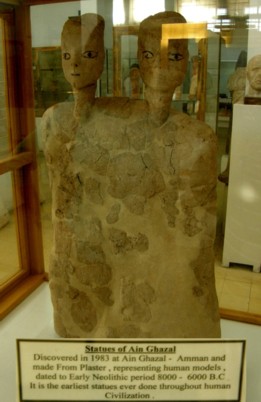
8,000+ year old statues in Amman Museum
Even the early Stone Age cultures of Syria and Egypt are impressive. Early human and animal figures in plaster stone and ceramics have been found.
Very sophisticated stone arrow heads and fish hooks as well as sophisticated pottery show not only a high level of manufacturing capability but an excellent means of acquiring; preserving; refining and improving; accurately recording; and disseminating knowledge. Perhaps they used now lost, drawings or early writing to complement the traditional teaching of elders and apprenticeship as can be found in aboriginal Australia. But aboriginal Australians either migrated to Australia before the bow and arrow and pottery were invented or lost this knowledge by some misadventure.
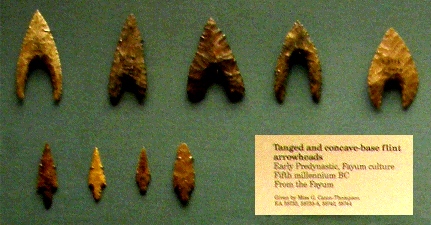
Stone arrow heads in the British Museum
The next technological leap is huge and must have involved written communications (as is confirmed by archaeological evidence), craft specialisation, numeracy and commerce.
I started my career in the iron and steel industry and know something of metal smelting. Metal smelting is not something you ‘wake up one morning and start doing’. It requires knowledge of high temperature kilns and furnaces, a sophisticated knowledge of high temperature ceramics (advanced pottery), in addition to a geologist’s knowledge of ores and fluxes.
One metal, gold, occurs naturally and can be melted directly at relatively low temperatures so it is possible that metal smelting began with gold but it is also possible that it began when potters were attempting to add high temperature glazes and discovered the first metals by accident.
Bronze is an alloy of copper and tin and in most cases these ores are found widely separated, so the true Bronze Age was preceded in the Iberian peninsular and probably in the Middle East by copper, tin and gold technology. It is difficult to stress the sophistication and depth of knowledge required to smelt then alloy metals. From chipping a flint stone tool to metals smelting is a technological leap of a similar magnitude, as ‘The Golden Hind’, Drake’s Elizabethan ship, to The Space Shuttle.
Anyone capable of harnessing these metals and the sophisticated communications and world view they imply had a new resource of immense advantage, spreading into every corner of commerce and society from warfare to agriculture; and so we see the great Bronze Age Egyptian, Mycenaean and Babylonian cultures begin.
The most dramatic and lasting evidence of these new capabilities are the Pyramids of Giza.

Sphinx with Great Pyramid in the background – Giza October 2010
These are at once evidence of the vast organisational capabilities and rapidly expanding knowledge of the early Bronze Age and a reminder of the limits to their world view.
The Bronze Age Egyptians placed their full confidence in a panoply of gods that explained away every event success, or disaster, providence cast their way. They committed vast resources and considerable parts of their lives to preparing for a highly improbable life hereafter.
As Byron put it:
What are the hopes of man? Old Egypt's King
Cheops erected the first pyramid
And largest, thinking it was just the thing
To keep his memory whole, and mummy hid;
But somebody or other rummaging,
Burglariously broke his coffin's lid:
Let not a monument give you or me hopes,
Since not a pinch of dust remains of Cheops[5].
Although quite a number of their carefully prepared mummies can now be seen partially unwrapped in climatically controlled rooms in Cairo, along with almost everything from Tutankhamun’s tomb and lesser contents from others, not a pinch of dust remains of Cheops.
These mummies are remarkable for being amongst the oldest preserved human remains on earth. It was interesting to speculate while wandering these rooms on the ridiculousness of their conception that, if correct, would have their souls returning to find them in a glass box in Cairo. I have had similar thoughts about the medieval knights transposed to the Cloisters in New York to await the second coming they believed imminent. Among the organs torn to pieces during mummification, to extract through the nose, was the brain, as the Egyptian soul resided in the heart; an idea that comes down through the Bible to popular culture; some superstitious believing this today, even after heart transplants have become commonplace.
Tutankhamun (1333-1324 BCE) was believed to be the son of Akhenaten (of monotheistic sun worship) referred to above. Still a boy he changed his name and reverted to polytheism under the influence of the priests.
Among the contents of Tutankhamun’s tomb on display are four Egyptian chariots. They were drawn by two small horses, light weight, equipped with quivers for arrows and carried a driver and an archer. The harnesses are quite advanced but the carriage lacks any suspension except that the passengers stand on a woven floor, probably leather, no longer in the carriages.

Chariot in the Egyptian Museum – Web photograph - no photography permitted.
The chariot was a technological advance used predominantly by the Hittites to allow the use of horses in battle. The Hittites developed a new chariot design that held three warriors instead of two. With it, together with bronze weapons, the Hittites gained control over Mesopotamia and eventually the whole of Syria, dominating trade routes, particularly trade in metals. In 1299 BCE Ramesses II attacked the Hittite city of Kadesh in what is thought to have been the largest chariot battle ever fought, involving some five thousand chariots. The city did not fall but Ramesses claimed the victory as the faster Egyptian chariots prevailed. The battle resulted in a treaty with the Hittites, the Kadesh peace agreement, which we saw some years ago at the Istanbul Archaeology Museum. This is believed to be the earliest example of any written international agreement of any kind. An enlarged copy of the agreement hangs in the UN building in New York.
This was a time of rapid technological advance for example in casting (mass producing) bonze weapon components, forging iron swords improved archery with composite re-curve bows and new forms of armour. The best bows required the strength of Heroes to draw them and the arrows had great range and penetrating power. Pikes and spears became formidable weapons.
Chariots continued to be important over the next thousand years but were eventually superseded by more manoeuvrable mounted cavalry as larger horses were bred and first girth straps then saddles were improved; culminating in the introduction of stirrups, from Asia during the Middle Ages.
By the time of Alexander the Great (330 BCE) chariots were as dubious a weapon as horse mounted cavalry is today. When attacked by chariots his cavalry simply parted then perused and destroyed them from the rear. After that they became a ceremonial and sporting vehicle used for parades, and games and circuses for public amusement during Greek and Roman times, where chariot races were enormously popular, being sponsored by wealthy patrons for political reasons and the object of gambling.
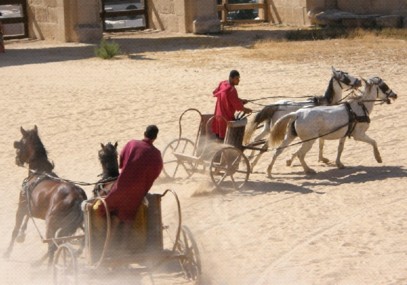
Re-enactment of a Roman chariot race – in the ancient Forum at Jerash - Jordan
There are references to the Kadesh battle in the hieroglyphics at the temples in Luxor, Karnak, and Abu Simbel. At Karnak our guide failed to point these records out, being rather more interested in the various gods depicted there. But we did see where Merenptah commemorated his victories over the ‘Sea Peoples’ on the walls of the Cachette Court.
During the reign of Merneptah (about 1224 BCE) and again during the reign of Ramesses III (about 1186 BCE) Egypt came under attack by ‘Sea Peoples’ a term coined by the Egyptians and recorded in the accounts of military successes inscriptions and carvings at Karnak and Luxor.
‘The foreign countries...made a conspiracy in their islands. All at once the lands were on the move, scattered in war… the unruly Sherden whom no one had ever known how to combat, they came boldly sailing in their warships from the midst of the sea, none being able to withstand them… Their league was Peleset, Tjeker, Shekelesh, Denyen and Weshesh’.
It is probable that the threat of the sea peoples armed with new iron weapons gave Ramesses II (1279 -1213 BC) incentive for strengthening Egyptian fortifications and for his grandiose buildings we still see today.
In the main temple at Karnak the sun god Amun-Re is hallowed. There is a large and famous statue of Ramesses II, amongst many other smaller figures at the site, and it is the second most publicised and visited place in Egypt after the Pyramids.
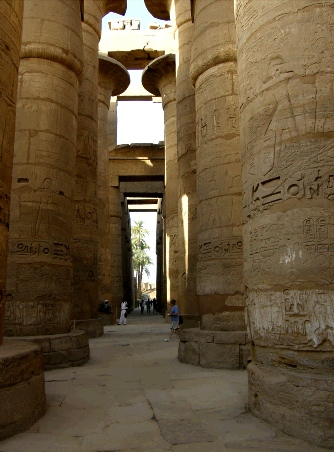
The Great Temple to Amun-Re at Karnak begun by Ramesses II
The development of iron technology was another giant leap forward. While bronze can be smelted in a relatively low temperature furnace similar to the one a blacksmith might use today, as we saw in use in Damascus, the temperature required to smelt iron can only be achieved in a much more sophisticated blast furnace, blown with preheated air. The feed for the furnace originally combined iron ore, charcoal and limestone (flux). The consumption of timber required to make charcoal was vast and occasioned the felling of entire forests.
Basic iron objects are brittle as cast and could only be toughened up by repeated reworking in a forge, beating-out and folding or drawing to oxidise the high carbon content. To make a superior sword or armour required many hours of work and great skill; but once steel quality was achieved made a weapon that, in the hands of a powerful soldier or Hero, could cut through bronze like butter.
As a result old civilisations, steeped in traditional ways and defended by conventional bronze weapons, fell to the barbarians: up-start with little respect for traditional arts and letters. And it was some time before the new regimes thus empowered began to develop their own cultural values, arts and religion. This period is known as the dark ages. Historians point out that the world was changing in other ways around 1200 BCE. This was a period of significant tectonic plate movement in the Mediterranean with two major, climate changing volcanic eruptions and several very large earthquakes. These may have weakened the established civilisations and left them more vulnerable to attack.
Visiting Egypt
On arriving in Cairo, and the usual airport cab hassles then the inability of the cab to find our hotel, a first priority was the Egyptian Museum and then a visit to Giza.
Cairo has a metro and a high priority was to try this out to avoid the, continuously lost, cabs as much as possible. It proved to be very good (£E1 = 20 Australian cents a trip) provided you can work it out for yourself. Asking for help was a formula for hostility, misunderstanding and/or misdirection. Men herd on and off the trains like bulls and signs like 'no exit' are completely ignored. There are separate 'women only' carriages. But on the train people are polite and often offered their seats and if you know what you are doing you are treated with efficiency and respect.
The metro is the best way to get close to the pyramids at Giza, just go to the Giza station and get a cab. While some desert is retained as a buffer zone, these are surrounded on three sides by the suburbs of Cairo.
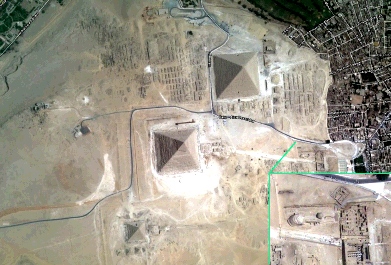
Giza Pyramids - enlarged sphinx in insert - Google Earth Photograph
Other metro stops get you to the ‘Opera’ on the Island in the Nile and the interesting Coptic Christian ghetto. Many pre-Constantine Christians fled to Egypt, particularly Alexandria to escape Roman persecution, so that the Coptic tradition in some ways precedes the establishment of the Roman church. The Church regards itself as the subject of many prophecies in the Old Testament. For example Isaiah Chapter 19, Verse 19 ‘In that day there will be an altar to the LORD in the midst of the land of Egypt, and a pillar to the LORD at its border.’ Because of the mutual Jewish roots in many ways the churches look more Islamic than Christian; but of course they precede Islam by 600 years.
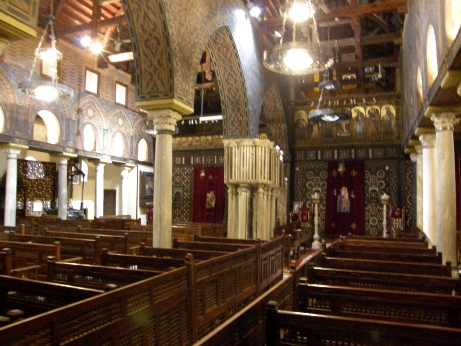
Coptic Church interior Cairo
After a couple of days in Cairo we took the train to Alexandria. This was interesting on several dimensions.
First was negotiating the touts at the Station in Cairo. We had the prescience to go the day before without any bags to buy return tickets. These had proven impossible to buy on-line; there is a facility but it seemed to be down. But in the event this was good because we took the metro to Murbarak where we were misdirected several times and accosted by one and all, before finding nearby Ramses station, which was behind scaffolding and a very dusty rubble-filled building site, and finally the ticket office. The next day with our bags, and then on our return, we negotiated it like locals.
The train runs through the Nile delta country and then westward along the coast to Alexandria. There was a vast array of crops under cultivation often in very small plots, including along the railway easement often up to the track (well fertilised). The predominant aid to human labour is the donkey. Agricultural machines are few and far between but wrecked cars were quite numerous. Everything looks desperately poor and the omnipresent rubbish piles were reminiscent of India, without the cows.
The train itself was something to behold. We had purchased first class tickets on the fastest express but externally the cars looked like anything but a quality express train. They were a dirty drab green and corroded; inside they were fine except that the outer pane of my double glazed window had a small hole and star crack in it as if it had been shot and was stained with rust. The cars were numbered in Arabic, the seats in Western numerals; another brief double-check required as 4 looks like a dyslexic 3. There are two stations in Alexandria and we got off too soon with most of the other passengers, requiring a long but interesting cab ride across the city. Despite our hotel being long established and prominent at the centre of the Corniche, again the cab driver could not find it (the old stop and ask technique). They always claim to understand where you want to go at the start of the trip.
The principal attraction in the city is the new and spectacular Library.
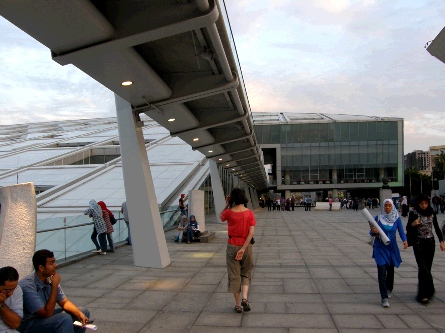
Library of Alexandria (Bibliotheca Alexandrina)
This commemorates the original famed ancient library of Alexandria, damaged by Julius Cesar and finally destroyed by the Christians, for its alleged pagan teaching and content, once Christianity became enshrined as the State religion. A bust of Alexander the Great stands in the forecourt.
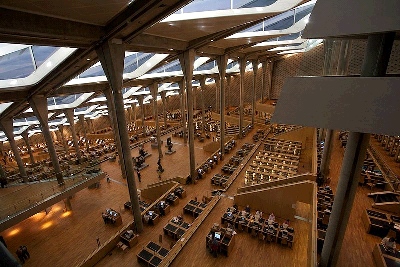
Bibliotheca Alexandrina Interior - web photo
The ancient Library was a seat of learning and education and its destruction is associated with the onset of the ‘dark ages’ of the common era. Some historians mark this point with the murder of ‘Hypatia of Alexandra’ in March 415. Hypatia was a famed female teacher; rationalist philosopher; mathematician; helio-centralist astronomer; experimental physicist and inventor of the hydrometer. The particularly brutal circumstances of her death have captured the imagination of many writers and artists since[6]. A recent movie ‘Agora’ dramatises these events.
Alexandria today is a wonderful example of a once prosperous and probably charming seaside resort town in tertiary decay. Among the redeeming features were the seaside restaurants; our hotel overlooking the square; the picturesque ancient trams; the small but good museum; the roman ruins including the small amphitheatre; and some quite nice, if run down, public gardens (not quite as nice as those in Broken Hill or Bathurst). But only someone fully up-to-date with their inoculations would enter the water.
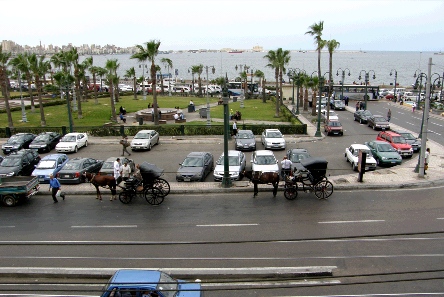
From Le Metropole Hotel Alexandria
From Cairo we flew to Luxor to pick up the Nile cruise. I’m going to skip over the next 24 hours as I intend to dine out on it. Suffice it to say if anyone is doing this you might want to talk to one of us first.
Luxor is built on the site of ancient Thebes and has the greatest array of ancient temples and associated ruins in Egypt. Together with Karnak nearby it is much more extensive and there is more to see than at Giza, most remains being around a thousand years more recent.
Tourism is the principal industry of Luxor, most being accommodated on dozens, perhaps hundreds of large, often palatial, river boats.
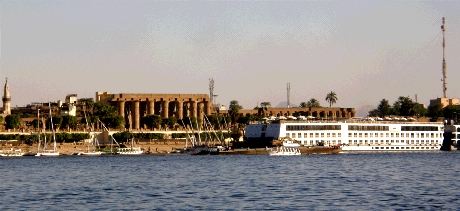
Luxor from the West Bank - the white objects are two river boats side-by-side
Major demolitions are presently in progress in order to uncover more of the ancient city, making the town very dusty and chaotic on the East bank. Ripping-off tourists is a major industry and we were told some tour groups are told not to go into town at all. Nevertheless bargaining for trinkets in the very extensive local markets was fun and good natured.
Across the river are the Valley of the Kings and Valley of the Queens as well as several large temples and tombs. The agriculture is predominantly sugar cane and the farmers seem very poor. We spent one night in a hotel on that side and caught the local ferry across (10 cents – less for locals).
Thebes was the capital of Egypt during the New Kingdom and glorifies the sun god Amon-Ra who was worshipped together with his wife, the Goddess Mut, and their son Khonsu, the God of the moon.
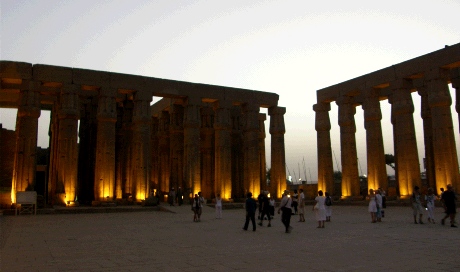
Luxor Temple
Thebes was attacked in 667 BCE by Assyrian emperor Assurbanipal who sacked it and left it in ruins, after which it fell in significance. But Alexander the Great was impressed by its temples and again raised its significance. Thebes is its Greek name. Later, during the Eastern Roman Empire, several of the temples were taken over by Christian monks. Their smoke has ruined the painting on some of the ceilings and they defaced a number of the images of Egyptian gods but not all. I thought this a mystery. Possibly parts were buried by sand or covered by wall hangings; or the task was unfinished; or they were objectionable in some areas only? Scaffolding and a considerable amount of time and effort would have been required.
In more recent times Napoleon’s troops used some features for target practice and European visitors carved their names and other graffiti into the walls.
Given our experiences to date in Egypt, the boat was more than we had expected. Our cabin was the size of a good hotel room with a large en suite, the claim that the ship was ‘five star’ was dubious but it was still very comfortable. We thought it excellent value as it included all meals, a guide, temple entrances connecting transport and several hours of rather pleasant felucca sailing near Aswan, where the Nile is particularly clean below the dams. Recommended.
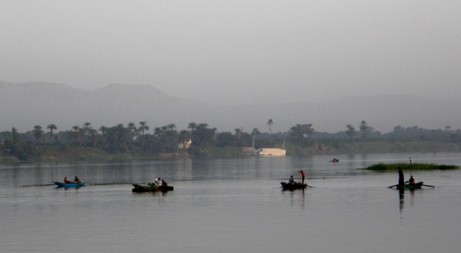
The Nile from our cabin in the morning
There was also entertainment. Although with only four English speakers, all Australian and all the other passengers Dutch, it was not directed to us nor was it very entertaining. There was a dervish and belly dancing show one night but we subsequently saw a much better show in Damascus.
The boat stopped at the principal ruins between Luxor and Aswan where we also paid a brief visit to the two dams, the old British dam and seven kilometres upstream the Aswan High earth-fill (rock and clay) dam built by the Russians.
In terms of volume of water volume this is the third largest reservoir in the world, and in engineering terms the eighth largest dam structure completed to date. Its main purpose is irrigation, increasing farmland 500% since 1970. The actual head (wall height) is relatively low and Electricity generation is consequently modest; it was built with a rated capacity of just 2.1 GW (twelve turbines, each alternator rated at 175 MW) but two units are not operating. Annual production is quite a bit less than Australia’s hydroelectricity generation (only 2.1% of our total). Compare this to the much smaller Three Gorges Dam in China that has a capacity of 18.2 GW and produces 80 TWh annually. New transmission infrastructure is very evident around Aswan and the upgrade, under a US aid programme appears to have included an increase in the output voltage, as well as the promised 10% improvement in turbine efficiency, partly to supply Egyptalum's nearby aluminium smelter at Nag Hammady. The equity of producing aluminium when a large proportion of the population have no electricity might be questioned.
Aswan itself is considerably up-market from the other Nile towns we visited, possibly with additional wealth generated maintaining the dam infrastructure, and of course, tourism.
Album: Egypt - Cairo, Alexandria and the Nile Temples
Visiting Syria
From Aswan we flew to Damascus in Syria. Possibly our good impression was as much as anything as a result of finding ourselves in a place where the locals did not spend a lot of time trying to take advantage of us and where on the whole they were friendly and businesslike; where the restaurants and cafés were well appointed, pleasant and good value; people seem happy and relatively prosperous; and where the layers of numerous civilisations and religions are still very evident throughout the old city. We had booked a middle range hotel on-line. This was near the central post office and the not operating central station; midway between the craft souq and museum and the old city. It was adequate.
We both enjoyed the city that has layer upon layer of history still evident at every turn and has excellent shopping opportunities. Highlights include the souqs in the old city that run for miles; some truly excellent restaurants; the Ommayad Mosque built in 705 CE when Damascus was the capital of the Arab Islamic Empire; Roman wall, arches and columns still standing; the grand home or palace of the Azem clan when the patriarch was Governor of Damascus in the eighteenth century, complete with Harem, fountains and rich appointments; and of course the citadel, mentioned earlier.
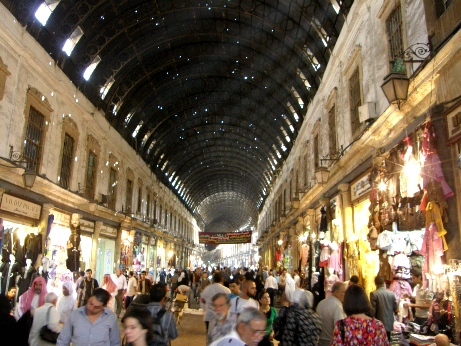
The main Souq in Damascus - Souq Midhat Basha
There is a substantial Coptic Christian minority and several Christian churches including an interesting chapel known as St Paul's church. Paul famously fled and hid here and changed his name from Saul of Tarsus. It was from here that he, with the author of John, set about formalising the Christian religion to distinguish it from a sect within Judaism; and set it on its path to becoming the official Roman religion. The rest is history.
From Damascus we made a day trip by bus to Bosra where there is a world heritage site. This comprises a medieval citadel, complete with moat, built entirely around a Roman theatre and extensive ruins of the old Roman town nearby.
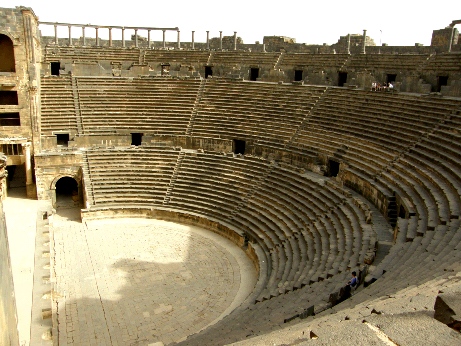
Theatre inside the Bosra Citadel
We can thoroughly recommend Syria*. It is not on the main Australian or US tourist agenda but it attracts a lot of European tourists.
*Jan 2016 Addendum:
We can't recommend a holiday in Syria anymore. Syria is now one of the most dangerous places on the planet.
I suppose that the flaring of sectarian violence should not come as such a surprise. European Christians fought amongst themselves for four centuries, burning opposing theologians and believers at the stake and killing millions, ostensibly over the authority of the Bishop of Rome and 'transubstantiation of the host'; but really over the reins of power.
Similarly, sectarian differences are being exploited in Syria in an attempt to grasp the reins of power.
As I mentioned in the introduction to this article (above), in 2010 Syria had many of the features of a police state having been under Emergency Law since 1962 and pictures of the President, Bashar al-Assad were everywhere (like Big Brother in Orwell's 1984). Although there was a referendum for President there was only one party (the Ba'ath Party) that originally came to power in a coup. But Syria was arguably as democratic as say Egypt or Saudi Arabia.
Assad and other key leaders in Syria are Alawite Muslims. The Alawite sect is a less fundamentalist branch of Shia Islam. Of some two and a half million Alawites worldwide about 60% live in Syria. But they are now outnumbered by the Sunni Muslims. Druze and Christians form a significant minority.
During the French mandate (1920-46) the Syrian elite were predominantly Sunni. Thus the Sunni continue to be represented widely within the Syrian Government and in society generally. According to Prof Fildis of Halic University in Istanbul, during the preceding Ottoman period, the Alawite were the most numerous and the poorest peasants in Syria, working for Sunni and Christian landlords in the mountain regions and in Latakia, at the foot of the Alawite mountains (source). But, like the Scottish highlanders, military service provided a route to improved social and economic position. Meanwhile the number of poor Sunni Arabs grew exponentially to around 70% of the population.
The French regarded the Alawites as a 'reliable minority' and administratively divided Syria into Sunni, Alawite and Druze states further emphasising racial and religious differences. The French mandate ended in 1946 and in 1958 Syria joined Egypt in the 'United Arab Republic' under President Nasser. This short lived union collapsed in 1961 when Syrian Army officers rebelled. Again in March 1963 a group of officers sized power and installed the Alawite dominated Ba'ath Party in Syria.
Since then attempts to restore Sunni ascendance or independence have been firmly suppressed by Assad and before him, his even more brutal father, resulting in long standing resentments.
These long term sectarian and racial differences provided fertile ground for the present civil war.
A year after we left this then peaceful country it became embroiled in the 'Arab Spring'. This was was at first an intellectual and middle class movement demanding additional democratic freedoms across the Middle East. It has since largely failed; in part because the educated middle class is a relatively minority particularly in Egypt and countries where rapid population growth has created a huge impoverished and uneducated, youthful and often fundamentalist, majority. For more discussion see: Six degrees of separation, conspiracy and wealth on this website.
In Syria middle class dissenters against Assad's authoritarian state began demonstrations aimed at removing him from office. There was a military crack-down.
A dissident group of military officers encouraged by the 'Arab Spring', styling themselves 'The Free Syrian Army', took over part of Damascus and declared it to be under a new, allegedly representative, government. Foreign interests opposed to Assad rushed to provide financial and other support.
Diverse interests saw this as an opportunity to overthrow the Syrian Government. Advanced military weapons and many millions of rounds of ammunition somehow fell into the hands of those opposed to the Syrian Government.
This included discontented Sunni Arab youths in regional towns.
It is obvious to anyone with the slightest military experience that unskilled boys are a liability as soldiers until trained. But in this case they provided plausibility to the trained foreign fighters who flooded into the country claiming to be Syrians rising up against their government.
Previously peaceful towns and villages soon became battle fields; then slaughter houses; then piles of rubble.
Western media was most often embedded with the rebels or 'freedom fighters' making it very hard to get a balanced view. Many of the images of Assad's 'atrocities' that assailed us each night on TV looked to me like obviously stage-managed concoctions. But then I was disinclined to believe them and was looking for staged events like: a man standing and then running towards the camera carrying a dust covered apparently seriously injured child (warning - some people may find this story distressing). Of course staging war scenes for the media is 'par for the course' in all war zones, on all sides.
See my comments on this and the 'Gas Attack' in the article: Syria Again on this website.
But instead of falling within weeks, as initially expected, Assad remained in control of the Syrian Government and has retained control of much of the economically significant parts of the country until the present.
Elsewhere, millions were forced to flee to neighbouring Turkey; Lebanon; Jordan; or Iraq.
Initially a new Government in exile was established in Qatar but in the rebel areas, the moderates and democrats were soon replaced by extreme Sunni radicals intent on violent jihad and the creation of a new Caliphate. The Islamic State of Iraq and al-Sham (ISIS, also known by the acronym of the Arabic - Daesh) coalesced out of the various anti-Assad forces and the Iraqi opposition. Soon ISIS/Daesh were executing embedded journalists and slaughtering towns and villages where they found Shia Muslims; Christians and Druze, vastly increasing the numbers of those fleeing the country. In June 2014 this group announced the Caliphate and a change of name to 'Islamic State' (IS).
Thus it is evident that, among those remaining in Syria, support for the Syrian Government has become polarised, with almost everyone in the government controlled areas now strongly supporting Assad. For the Christians; Druze; Alawites; and other non-Sunni Muslims there is little other choice. If IS or other Sunni extremists win the war it seems inevitable that they will be slaughtered like their coreligionists in the towns and cities that have fallen to the rebels. Thus in 2014 elections were held under a new constitution allowing multiple parties. Eight parties competed and there were observers from more than 30 countries. The rebels did not allow voting in the areas that they controlled. The Ba'ath Party, led by Assad, won 88.7% of the vote.
There is little doubt that the well equipped forces opposing Assad, including IS, got many of their weapons and ongoing ammunition (through intermediaries) from Western and Sunni Arab sources. At different times they have enjoyed endorsements from the leaders of the US, Britain, France, Turkey, Israel and Saudi Arabia (an interesting alliance). As any general knows without lines of supply, and particularly ammunition, a war is quickly lost. As the Syrian opposition is still fighting four years into the war we must conclude that this pipeline remains open.
Assad has been cast as a monster and the originator of all the suffering and the flood of refugees. This flies in the face of the obvious. As we saw in 2010 Syria was then peaceful and perhaps the nicest country to visit in the Middle East.
It's obvious that it is those who plotted the downfall of the Syrian Government (and are still supplying the materiel) who are responsible for all this death, destruction and suffering.
Now, belatedly, our Western governments realise that in supporting the attempted overthrow of Assad we have inadvertently breathed life into a monster that threatens our own societies.
In repeatedly playing God in the Middle East we have reached up this new Islamic Caliphate from the bitterness and hatred of the fundamentalist; given disgruntled Sunnis worldwide a rallying cry; suggested Jihad and suicide attacks as a means of satisfying their discontent; and created the greatest flood of refugees this century. Read more of this in Jihad on this website.
Album: Syria - Damascus & Bosra
Visiting Jordan
After Damascus we went by bus to Amman in Jordan where we hired a car to go to some of the more interesting places including Jerash, Petra and the Dead Sea, for a float.
The Roman ruins at Jerash are particularly interesting as many have survived because the town was effectively abandoned for a considerable period, with many structures dating to the time of the emperor Hadrian. There is a well preserved forum and two roman theatres in good condition, as well as a long colonnaded street. More remains than say at Ephesus in Turkey, which dates to about the same period.
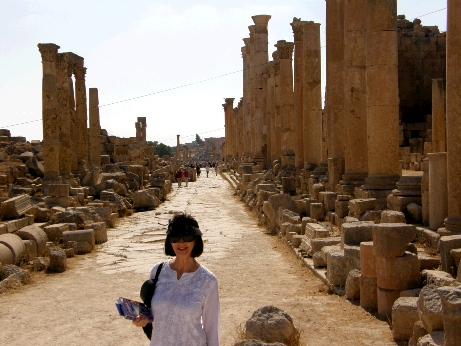
Jerash - Jordan
Petra is an entirely different proposition. It is around the same age as Jerash but being carved out of the local, relatively soft, pink and red sandstone has become heavily eroded, with the notable exception of a couple of well known less exposed facades, like the famous Treasury. For example there is a largish amphitheatre carved from the stone but it is no longer useable as the seats are so eroded as to be more like slopes. The site is very extensive but most of the remains are ruins or little more than shallow caves. It is a city of facades.
Petra remained unknown to the Western world until 1812, when it was ‘rediscovered’ by Swiss explorer Johann Ludwig Burckhardt and became famous in Victorian Europe as a result of a poem ‘Petra’ by John William Burgon (written in 1845):
It seems no work of Man's creative hand,
by labour wrought as wavering fancy planned;
But from the rock as if by magic grown,
eternal, silent, beautiful, alone!
Not virgin-white like that old Doric shrine,
where erst Athena held her rites divine;
Not saintly-grey, like many a minster fane,
that crowns the hill and consecrates the plain;
But rose-red as if the blush of dawn,
that first beheld them were not yet withdrawn;
The hues of youth upon a brow of woe,
which Man deemed old two thousand years ago,
match me such marvel save in Eastern clime,
a rose-red city half as old as time.
Since then it has gained increasing popularity as a tourist destination. UNESCO has described it as ‘one of the most precious cultural properties of man's cultural heritage’ and Petra was chosen by the BBC as one of ‘the 40 places you have to see before you die’. The site is also featured in many films including: Indiana Jones and the Last Crusade.
Recollection of the Burgon poem got me smiling. Unfortunately I also remember, all too well, the Peter Sellers parody, (written by Frank Muir and Denis Norden of ‘My Word’ fame), about Bal-ham gateway to the South.
Balham is a very ordinary South London suburb (think Ryde in Sydney) not far from where I once lived when I worked in London (click below to hear it - the poem is near the end):
| No responsibility is accepted for linked third party video or media content - see Terms of Use and Copyright. |
Broad-bosomed, bold, becalmed, benign
Lies Bal Ham, four-square on the Northern Line.
Matched by no marvel save in Eastern scene
A rose-red city, half as Golders Green (Golders Green being another London Suburb)
The Petra landscape and setting is beautiful and awe inspiring.

My version of the most common photograph of Petra – the Treasury glimpse.
But with its horses led on a halter (no taking the reins); cute little carriages; camels; and a vast phalanx of tourists trudging up and down, there definitely is a Disneyland atmosphere about Petra that kept me smiling. At one stage the milling of the tourists, all trying to get a snap of their friend before tombs for Facebook, got so frenzied it was truly comical.
It is interesting that such a large city could prosper; then be abandoned on the basis of changes in ancient trade routes; then be forgotten so quickly; a bit like Angkor Thom in Cambodia. It is an experience to be recommended, before a million trudging feet destroy it completely.
On the downside, although very convenient being just up the road from the entrance, and easy parking for the car, the hotel was about the worst value of any we stayed in the whole trip. Petra is the ultimate tourist trap.
On the way back we drove for part of the way, through small towns and detours, along the Kings Highway, once a Roman road and before that a trade route along which many traders and armies have travelled (including, in legend, Moses on his way to slaughter the inhabitants of Jericho). It was quite an adventure with the local traffic, unmade sections, and school children throwing water at the car.
After regaining the better road at Madabar we made our way down spectacular gorges to the Dead Sea. As it is so close to Israel this involved passing the inevitable security stop points on the way to one of the resorts, which provide access to the water, the absolutely essential showers and so on. Check points are fairly frequent across Jordan but there was no problem with them at any point on the trip. Swimming in the sea requires non-conventional techniques which I attempted to perfect. Any attempt to raise one arm or one leg immediately flips you over. Lying on your back, frog kicking and arm rowing is best and fastest; breast-stroke works but legs have to be out of the water and there is a risk of getting water on your face or mouth – it stings. Nearby is the purported baptism site of Jesus (by his cousin John the Baptist) but we gave that a miss.
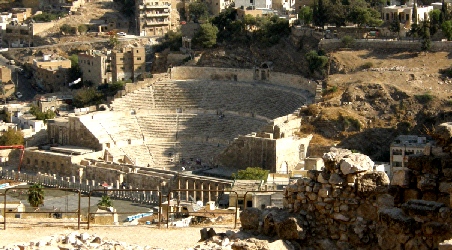
The Roman theatre in Amman – Jordan - from the citadel
A common theme to be drawn from the many ruins of many past cultures we visited during the trip is the vast engineering and economic resources that have been dedicated by civilised man to one, soon to be overthrown religion, after another. Each in its time is the only sure way to an afterlife; each with improbable panoplies of beliefs; each worth shedding their adherent’s last drop of blood for; against the unbelievers who hold some other method of securing immortality.
But above all, we were presented with the enormous complexity of the flow of civilisation, to bring us to the present day and our existence, and thus our ability to contemplate all this. I was constantly reminded that unless it all happened just as it did I would not be here. In that way we each owe our existence to the exact past as it was: every one of the pharaohs of Egypt and Kings of other lands; all their priests and subjects; the inventors of bronze and iron, swords and chariots; the warriors and heroes of Greece and Rome; Alexander; Saladin and Richard; Napoleon and Nelson; those wanderers in the desert and mediators in caves; the fabulist creators of Isis and Zeus and all the Gods man has prayed to; Moses and Abraham; Jesus, John and Paul; Muhammad; and all the religions along the way. What a rich tale!
The same applies to their presence, of some future scribbler. Everything we do determines their existence; or not. We bring the people of the future into existence just as Ramesses, Einstein and even Hitler did for us.
Album: Jordan - Petra, Jerash, Amman
Footnotes:
[1] All photos are mine except where indicated.
[2] Its lack suggests they block any program lending support to a view that that the Earth may be but one of many trillion-trillion bodies in the universe; that modern humans have been around for less than 0.0005% of the life of this universe; that we are probably just one of an infinity of possible organisations of common cells in the evolutionary continuum of life on earth and like all such organisms, from bacteria to rose bushes, may have no special immortality; that our religions are ephemeral and are demonstrably authored by men, largely for political reasons; or that we and our works are thus likely be of no special interest to any of the pantheon of hypothetical, often highly imaginative, deities, to whom people have prayed for the past ten millenia. Why do they so often have animal heads; or human heads and animal bodies?
[3]Cleopatra was famously Machiavellian. She learned Egyptian, as well as her native Greek, and represented herself to the people as the reincarnation of the Egyptian goddess Isis. She originally ruled jointly with her father Ptolemy XII and later with her brothers, Ptolemy XIII and Ptolemy XIV, whom she married in accordance with Egyptian custom, but eventually she became sole ruler. As pharaoh, she consummated a liaison with Julius Caesar that solidified her grip on the throne and later elevated her son with Caesar, Caesarion, to co-ruler in name. After Caesar's assassination in 44 BC, she aligned with Mark Antony in opposition to Caesar's legal heir, Gaius Iulius Caesar Octavianus (later known as Augustus). With Antony, she bore the twins Cleopatra Selene II and Alexander Helios, and another son, Ptolemy Philadelphus. Her unions with her brothers produced no children. After losing the Battle of Actium to Octavian's forces, Antony committed suicide. Cleopatra followed suit, according to tradition killing herself by means of an asp bite on August 12, 30 BC. She was briefly outlived by Caesarion, who was declared pharaoh, but he was soon killed on Octavian's orders.
[4] Iconoclasm was proscribed at the Second Council of Nicaea 787, when the making of religious representational art was officially endorsed by the church; thus bowing to established Roman artistic sensibilities and laying the ground for some of the greatest art ever made. But iconoclasm re-arose on a grand scale with the Protestant Reformation; after biblical scholars reinstated the historical Second Commandment, prohibiting the making of idols (or any religious images of people or animals). This is a Comandment followed by both Judaeism and Islam as well as some early Christians.
[5] Great Khufu Pyramid (Cheops in Greek) 2580-2560 BCE. George Gordon, Lord Byron (1788-1824) - from Don Juan
Or as Shelly, Byron’s friend, put it reflecting similarly on Ramesses II (Ozymandias in Greek); his imagined arrogance; the ephemeral nature of existence, position and fame; and the futile attempts of the powerful at self-preservation:
I met a traveler from an antique land
Who said: Two vast and trunkless legs of stone
Stand in the desert. Near them, on the sand,
Half sunk, a shattered visage lies, whose frown,
And wrinkled lip, and sneer of cold command,
Tell that its sculptor well those passions read
Which yet survive, stamped on these lifeless things,
The hand that mocked them, and the heart that fed;
And on the pedestal these words appear:
"My name is Ozymandias, king of kings:
Look on my works, ye Mighty, and despair!"
Nothing beside remains. Round the decay
Of that colossal wreck, boundless and bare
The lone and level sands stretch far away.
Percy Bysshe Shelley - 1818
[6]A Christian mob led by a man called Peter: ‘waylaid her returning home, and dragging her from her carriage, they took her to the church called Caesareum, where they completely stripped her, and then murdered her by scraping her skin off with tiles and bits of shell. After tearing her body in pieces, they took her mangled limbs to a place called Cinaron, and there burnt them.’ - Socrates Scholasticus Ecclesiastical History, Book VI: Chap 15. A Pre-Raphaelite painting by CW Mitchell (prior to flaying) romanticises this.
